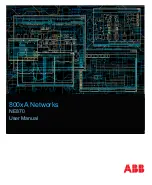
Chapter 13 Spanning Tree Protocol
XGS1930 Series User’s Guide
149
Configuration
Digest
A configuration digest is generated from the VLAN-MSTI mapping information.
This field displays the 16-octet signature that is included in an MSTP BPDU. This field displays the
digest when MSTP is activated on the system.
Topology
Changed Times
This is the number of times the spanning tree has been reconfigured.
Time Since Last
Change
This is the time since the spanning tree was last reconfigured.
Instance
These fields display the MSTI to VLAN mapping. In other words, which VLANs run on each
spanning tree instance.
Instance
This field displays the MSTI ID.
VLAN
This field displays which VLANs are mapped to an MSTI.
MSTI
Select the MST instance settings you want to view.
Bridge
Root
refers to the base of the MST instance.
Our Bridge
is this switch. This Switch may also be
the root bridge.
Bridge ID
This is the unique identifier for this bridge, consisting of bridge priority plus MAC address. This ID
is the same for
Root
and
Our Bridge
if the Switch is the root switch.
Internal Cost
This is the path cost from the root port in this MST instance to the regional root switch.
Port ID
This is the priority and number of the port on the Switch through which this Switch must
communicate with the root of the MST instance.
Port
This field displays the number of the port on the Switch.
Port State
This field displays the port state in STP.
•
Discarding
– The port does not forward or process received frames or learn MAC
addresses, but still listens for BPDUs.
•
Learning
– The port learns MAC addresses and processes BPDUs, but does not forward
frames yet.
•
Forwarding
– The port is operating normally. It learns MAC addresses, processes BPDUs
and forwards received frames.
Port Role
This field displays the role of the port in STP.
•
Root
– A forwarding port on a non-root bridge, which has the lowest path cost and is the
best port from the non-root bridge to the root bridge. A root bridge does not have a root
port.
•
Designated
– A forwarding port on the designated bridge for each connected LAN
segment. A designated bridge has the lowest path cost to the root bridge among the
bridges connected to the LAN segment. All the ports on a root bridge (root switch) are
designated ports.
•
Alternate
– A blocked port, which has a best alternate path to the root bridge. This path is
different from using the root port. The port moves to the forwarding state when the
designated port for the LAN segment fails.
•
Backup
– A blocked port, which has a backup or redundant path to a LAN segment
where a designated port is already connected when a switch has two links to the same
LAN segment.
•
Disabled
– Not strictly part of STP. The port can be disabled manually.
Designated Bridge
ID
This field displays the identifier of the designated bridge to which this port belongs when the
port is a designated port. Otherwise, it displays the identifier of the designated bridge for the
LAN segment to which this port is connected.
Designated Port ID
This field displays the priority and number of the bridge port (on the designated bridge),
through which the designated bridge transmits the stored configuration messages.
Designated Cost
This field displays the path cost to the LAN segment to which the port is connected when the
port is a designated port. Otherwise, it displays the path cost to the root bridge from the
designated port for the LAN segment to which this port is connected.
Table 66 Advanced Application > Spanning Tree Protocol (continued)
LABEL
DESCRIPTION
Summary of Contents for XGS1930-28HP
Page 19: ...19 PART I User s Guide...
Page 39: ...39 PART II Technical Reference...
















































